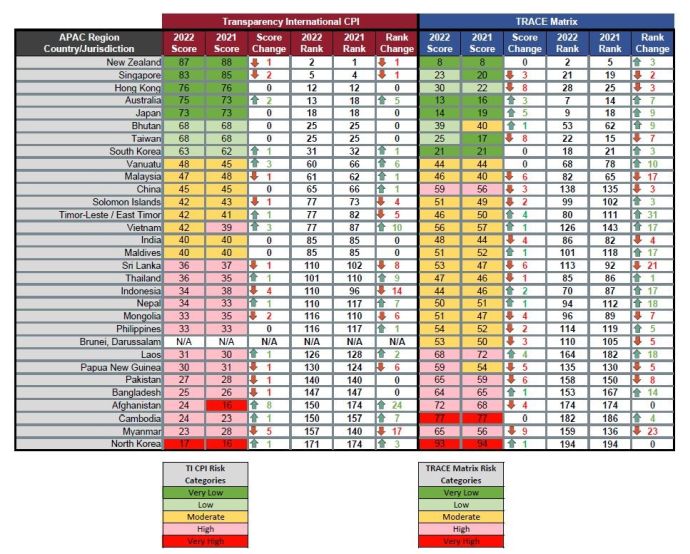The risk of bribery and corruption in Asia Pacific (APAC) countries in 2022 remained above the global average, according to two anti-corruption due diligence tools, Transparency International's 2022 Corruption Perceptions Index (TI CPI) and TRACE's 2022 Bribery Risk Matrix (TRACE Matrix). The two present largely consistent results, but the different methodologies and scoring they use allow for a more complete and accurate view of the risks and opportunities offered in the APAC region when considered together.
The average score of APAC countries was above the global average TI CPI score (45 versus 43, as for the past three years), but more than half of the countries in the region continue to be perceived as high to very high risk for bribery and corruption. TRACE considers two thirds of the countries in the region to be moderate to very high risk. The 2022 TI CPI is available here, and the 2022 TRACE Matrix publication packet is available here.
While these tools are helpful in risk assessment, they should not be used in place of adequate risk-based due diligence on regional counterparties. Many international bribery cases involve businesses with headquarters or banking activities in nations with relatively low risk ratings, such as last year's FCPA case against KT Corporation for its operations in South Korea and Vietnam. Therefore, other publicly available reports on money laundering and bank secrecy risks should be considered to develop a more complete understanding of the potential bribery and corruption risks in a particular country in the region.
Summary
Both the TI CPI and the TRACE Matrix rank New Zealand, Australia, and Japan among the countries in the APAC region with the lowest risk of corruption. However, the CPI also includes Hong Kong and Singapore in that category, while the Matrix ranks those two countries slightly lower, though still low risk, because the Matrix includes an analysis of media freedom and civil society engagement. While Cambodia, Afghanistan, and North Korea rank at the bottom of both, the CPI also includes Myanmar, due to a five-point drop as conditions worsen after the military coup in 2021.
The CPI scores and rankings have remained largely stable for years, although in 2022, the countries with the largest scoring improvements (Vietnam and Afghanistan) also saw improvements in their risk status. However, none of the countries with the biggest declines in CPI rankings (Indonesia and Myanmar) saw any material change in their risk scale.
In contrast, there was some downward movement in the Matrix with Singapore and Taiwan moving from very low to low, and Papua New Guinea from moderate to high.
As shown in the chart below, there are directional discrepancies in scores and rankings when comparing the results of the two instruments, as can be observed in the cases of Afghanistan (improving on the CPI, but declining on the Matrix) and Indonesia (declining on the CPI, but improving on the Matrix). In certain cases, the Matrix indicates a major improvement or drop while the CPI shows no change (Japan, Bhutan, Taiwan, and Maldives).
Methodologies
Both the TI CPI and the TRACE Matrix evaluate performance and assign a score between 1 to 100 to every country and jurisdiction, and then assign a rank based on the score. For the CPI, the risk score is inverse to the risk rank, while for the Matrix, a high score translates to a high-risk rank. For example, the least corrupt APAC country on both charts, New Zealand, is ranked in second place on both the CPI and on the Matrix but got a score of 87 on the CPI and 8 on the Matrix (a decrease of one rank and one point on the CPI from 2021). In contrast, the country at highest risk, North Korea, is ranked 174 on the CPI and 194 on the Matrix, but received scores of 17 and 93, respectively.
The CPI measures perceptions of public corruption from 13 data sources, but excludes indicators such as private sector corruption, money laundering, foreign bribery, and the prevalence in certain jurisdictions of enablers of corruption (lawyers, accountants, financial advisors, etc.).
In contrast, the Matrix focuses on commercial and business risks besides public corruption, and weighs other information in addition to perceptions. Generally, the Matrix publishes scores for four corruption indicators, including the opportunity for bribery (government interaction, expectation, and leverage), deterrence (dissuasion and enforcement), transparency (government and civil service), and oversight (free press and civil society), together which provide granularity for interpreting the measurements.
Jurisdictions of Note
China remains absolutely at the average for the APAC region (45), slowing its upward trajectory from past years on the CPI. On the Matrix, China declined in its score by 3 points and moved down in the rankings 3 points, and so did not improve its overall risk rating from the downgrade it experienced in the Matrix rating in 2021.
Hong Kong SAR stayed the same on the CPI, still ranking very low in corruption risk, halting the decline in 2021. But it continued to decline on the Matrix, by 8 points on its score and 3 ranks, though staying at low risk. TRACE explains that the decline in Hong Kong's ability to deter bribery and the decreased transparency in the city's government and civil services contributed to the continued decline.
Malaysia continues to decline in its scores and rankings on both the CPI and the Matrix (down 1 and 6 points on its score, 1 and 17 in rankings), as does Myanmar (down 5 and 9 points on its score, 17 and 23 in rankings). While Sri Lanka has declined precipitously on the Matrix (down 6 and 21, respectively), and its "ever-worsening economic situation" and political unrest was noted by TI, its CPI score and ranking was not much affected in 2022 (down 1 and 8, respectively). The improvement in Vietnam (up 3 and 10, respectively) on the CPI resulted in a shift in its risk scale (from high to moderate), while similar progression on the Matrix (up 1 and 17, respectively) had no such impact. Afghanistan's advance on the CPI (up 8 and 24, respectively) lead to comparable risk improvement (from very high to high), while it experienced a decline in score on the Matrix (by 4) and no change in rankings and risk scale.
Conclusion
While several Asian countries were shown to be making modest progress in their fight against corruption, overall the APAC region continues to "stagnate" on the CPI and the Matrix in 2022. Both TI and TRACE made remarks on the worrying signs such as restrictions on basic freedom imposed during the pandemic, as well as the reduced dissent or criticism of the government in certain jurisdictions. Still, there is some positive light in the region, including more stringent corporate liability in new legislation and heightened overall market pressure to address environmental, social, and governance (ESG) compliance, disclosure, and monitoring.
Companies having operations in the APAC region should be wary of corruption in countries with greater risks, but they should also be mindful that a country with a relatively low risk does not guarantee a low risk of the counterparty engaging in bribery and corruption. Only companies with corporate compliance systems that are adapted to the local regulatory framework, capable of successfully reducing corruption risks, and integrated into business operations and management procedures can safely take advantage of the opportunities in the region.

The content of this article is intended to provide a general guide to the subject matter. Specialist advice should be sought about your specific circumstances.


